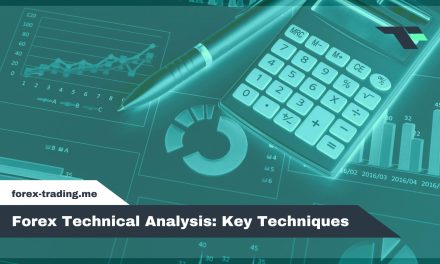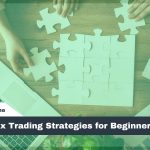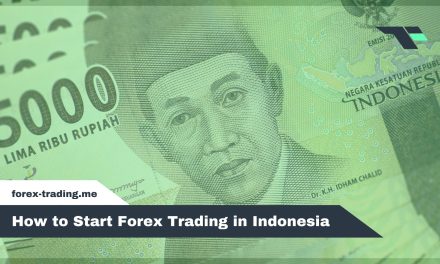
Best Forex Trading Strategies for Beginners

Beginner forex traders should focus on simple moving average crossovers, which achieve approximately 60% accuracy, combined with RSI and MACD oscillators for entry timing. Scalping techniques targeting 5-10 pips with 1:1.5 risk-reward ratios work well for short-term trades. Economic calendar monitoring helps identify high-impact events that create 50-100 pip movements. Essential practices include risking only 1-2% per trade, maintaining detailed trade journals, and using regulated brokers with demo accounts for practice. These foundational strategies provide extensive knowledge for trading success.
Table of Contents
Technical Analysis Basics for Forex Trading
Technical analysis provides beginner traders with visual tools to interpret currency movements through historical price data, eliminating the need to constantly monitor complex economic news. Moving averages serve as foundational indicators that can signal potential trend shifts when shorter-period averages cross above or below longer-period ones, while oscillators like RSI and MACD help traders identify prime entry and exit points by measuring momentum and overbought or oversold conditions. Although simple moving average crossovers demonstrate approximately 60% accuracy in backtesting scenarios, novice traders should understand that success rates vary considerably based on market conditions, risk management practices, and the consistency of their chosen analytical approach.
How do moving averages signal trend shifts with price action?
How can traders identify the precise moment when market momentum begins to shift direction? Moving averages provide clear signals through crossover patterns and slope changes that reveal emerging trends. When a faster exponential moving average crosses above or below a slower simple moving average, it indicates potential trend reversal. The popular 50-period and 200-period SMA crossover strategy demonstrates approximately 55% win rate in Forex backtests, making it reliable for beginners. Exponential moving averages react 25% faster than simple moving averages on identical periods, reducing lag and providing earlier signals.
Additionally, observing the slope of moving averages helps confirm trend strength. When multiple moving averages align in the same direction, they create stronger confluence for trend confirmation, enabling traders to enter positions with greater confidence.
Which oscillators improve timing of trade entries?
When traders seek to refine their entry points beyond basic trend identification, oscillators provide essential insights into market momentum and timing. These technical indicators help identify overbought and oversold conditions, signaling potential reversal points where traders can enter positions advantageously.
Three key oscillators enhance entry timing:
- RSI (Relative Strength Index) – Signals overbought conditions above 70 and oversold below 30 in 80% of standard interpretations, indicating potential reversal zones.
- MACD (Moving Average Convergence Divergence) – Shows divergence patterns that precede trend reversals in up to 65% of cases, offering early warning signals.
- Stochastic Oscillator – Measures momentum by comparing closing prices to price ranges, identifying when trends may be losing strength and preparing to reverse direction.
What success rate can beginner traders typically see?
Why do most beginner traders struggle to achieve consistent profitability in their early forex trading endeavors? Industry surveys reveal that only 10-15% of new traders achieve profitability after six months of active trading. The shift from demo to live accounts presents significant psychological challenges, with demo account win rates averaging 40% higher than live trading results.
| Trading Phase | Typical Success Rate |
|---|---|
| First Month | 5-8% |
| Three Months | 8-12% |
| Six Months | 10-15% |
| One Year | 15-20% |
| Two Years | 20-25% |
The steep learning curve reflects multiple factors including emotional pressure, inadequate risk management, and unrealistic expectations. New traders must understand that developing consistent profitability requires patience, disciplined practice, and realistic performance expectations during their initial trading period.
Price Action and Scalping Techniques
Price action and scalping techniques represent a powerful combination for beginners seeking to capitalize on short-term market movements through precise entry and exit points. Scalpers typically target 5-10 pips per trade while holding positions for just 1-5 minutes, relying on clean price signals rather than complex indicators to make rapid trading decisions. Success in this approach requires mastering the identification of key support and resistance levels, establishing appropriate risk-to-reward ratios for quick trades, and thoroughly testing these strategies through demo account simulations before risking real capital.
How to identify support and resistance zones accurately?
Success in forex trading often hinges on a trader’s ability to identify key support and resistance zones, which represent horizontal price levels where currency pairs historically encounter buying or selling pressure. These psychological barriers form when price repeatedly stalls at specific levels, creating areas where traders anticipate future reactions.
Effective zone identification requires systematic analysis of historical price movements. Traders should focus on swing highs and lows, as these pivot points frequently become future support or resistance levels. Here are three essential methods for accurate zone identification:
- Locate multiple touchpoints – Zones with at least three historical price reactions demonstrate 50% higher validity
- Mark psychological levels – Whole numbers coincide with support/resistance zones in 65% of cases
- Validate through timeframe confluence – Confirm zones across multiple timeframes for increased reliability
What risk-to-reward ratio suits quick scalp trades?
Quick scalping operations require traders to maintain risk-to-reward ratios that account for the compressed time frames and elevated transaction costs inherent in this trading approach. A 1:1.5 risk-to-reward ratio represents the common standard among scalpers, providing sufficient reward potential to offset spreads and slippage while maintaining realistic profit targets. Since brokers typically charge 0.5 to 1 pip spreads on major pairs like EUR/USD, scalpers must factor these costs into their ratio calculations to preserve profitability.
The compressed nature of scalp trades demands tight control over risk management, as small movements can quickly erode profits when transaction costs accumulate. Successful scalpers consistently apply these ratios across multiple trades, recognizing that individual trade outcomes matter less than overall statistical performance over time.
How to simulate scalping strategies on a demo account?
Mastering scalping strategies through demo accounts requires traders to configure their practice environment with settings that mirror live market conditions as closely as possible. Proper simulation guarantees skill transfer when moving to live trading, with studies showing 80% success rates when realistic conditions are maintained.
Essential configuration steps include:
- Spread and execution settings – Configure realistic spreads and order execution speeds that match live market conditions rather than artificially perfect fills
- Real-time market data – Enable live price feeds and market volatility to experience authentic trading scenarios during active market hours
- Position sizing discipline – Use actual account percentages and risk management rules intended for live trading
Completing at least 100 simulated scalp trades provides sufficient practice volume. The replay feature allows traders to practice during off-market hours while maintaining realistic market dynamics.
Fundamental Analysis Essentials
Fundamental analysis requires traders to understand how economic indicators, central bank decisions, and geopolitical events influence currency values through systematic evaluation of macroeconomic data. The economic calendar serves as an essential tool for tracking approximately 20 major weekly releases, including employment reports, inflation data, and GDP figures that generate roughly 65% of daily foreign exchange volatility.
Central bank interest rate announcements carry particular significance because they directly affect currency demand, as higher rates typically attract foreign investment and strengthen the domestic currency relative to trading partners.
How to read an economic calendar for major releases?
Economic calendars serve as essential roadmaps that reveal when governments and financial institutions will release vital data capable of triggering considerable currency movements. These tools help traders anticipate volatility spikes and prepare for potential trading opportunities by displaying upcoming economic events in chronological order.
Understanding how to filter and prioritize calendar events becomes important for effective trading decisions:
- High-impact events appear marked with three red bars in most economic calendars, indicating their potential to create substantial market movement
- Forecast versus actual comparisons reveal surprise factors that can immediately move currency pairs by 50-100 pips when results deviate greatly from expectations
- Revision impact assessments show how previously released data corrections affect market sentiment and ongoing currency trends
Mastering economic calendar interpretation enables traders to position themselves strategically before major announcements.
Which macroeconomic reports move currency pairs most?
Certain macroeconomic indicators possess the power to trigger immediate and substantial currency movements, making them essential focal points for traders seeking to understand market volatility patterns. These reports fundamentally alter market sentiment and drive significant price action across major currency pairs.
| Report Type | Average Price Impact | Release Frequency |
|---|---|---|
| Nonfarm Payrolls | 100+ pips | Monthly |
| CPI Data | 70 pips (EUR/USD) | Monthly |
| GDP Reports | 50-80 pips | Quarterly |
| Interest Rate Decisions | 150+ pips | Variable |
Understanding which data releases generate the most volatility enables traders to prepare for potential opportunities and manage risk effectively. GDP figures, unemployment rates, and trade balance reports also create meaningful movements, though typically less dramatic than employment and inflation data. Successful traders monitor these key indicators to anticipate market reactions.
Why do central bank interest rate decisions impact Forex?
When central banks adjust their benchmark interest rates, they fundamentally alter the attractiveness of their currency to international investors, creating immediate and often dramatic shifts in foreign exchange markets. Rate changes affect currency yield differentials, prompting significant capital flows as investors seek higher returns.
The mechanics linking policy announcements to forex movements involve several key factors:
- Interest rate differentials – Higher rates attract foreign investment, increasing currency demand
- Yield curve adjustments – Policy changes reshape expected returns across different time horizons
- Quantitative easing impacts – Asset purchase programs affect money supply and currency valuation
Federal Reserve rate decisions typically move USD pairs by 80-120 pips on average. Unexpected rate hikes demonstrate a 75% probability of strengthening the affected currency, making central bank announcements critical events for forex traders.
Broker Selection and Platform Features
After mastering fundamental analysis, traders must carefully select a regulated broker whose platform provides the execution speed and features necessary for profitable trading. Verifying broker credibility through regulatory checks with top-tier authorities like the FCA or ASIC helps guarantee capital safety, while understanding how different order types function on the chosen platform can greatly improve trade execution efficiency. The relationship between spreads, commissions, and net profitability directly impacts trading results, making platform cost structure evaluation essential before committing to any brokerage service.
How to verify broker credibility through regulation checks?
The credibility of a forex broker hinges substantially on its regulatory status, which serves as the primary safeguard between traders and potential financial misconduct. Regulatory oversight guarantees brokers adhere to financial standards and client protection protocols, making verification vital for novice traders.
Confirming broker legitimacy involves straightforward steps that require minimal time investment:
- Check official registries – Visit regulator websites like FCA register or ASIC license databases to verify broker authorization status
- Verify segregated accounts – Confirm brokers maintain segregated client accounts, which greatly reduces fund misuse risk
- Cross-reference multiple sources – Compare information across different regulatory bodies to guarantee thorough verification
Checking the regulator’s public registry takes under two minutes online, making this verification process both accessible and efficient for beginners seeking reliable trading partnerships.
What order types enhance execution speed on your platform?
Beyond selecting a regulated broker, novice traders must understand how specific order types can dramatically improve their execution efficiency and reduce trading costs. Market orders execute immediately at current prices but often result in slippage during volatile periods. Limit orders allow traders to specify exact entry or exit prices, potentially reducing execution costs by up to 20% compared to market orders by avoiding unfavorable price movements.
Stop orders trigger market orders when predetermined price levels are reached, providing automated risk management. OCO (one-cancels-other) orders combine multiple order types, automatically canceling remaining orders when one executes, preventing double exposure during volatile market moves. Understanding these order mechanisms enables beginners to automate their trading strategies while minimizing reaction time requirements and emotional decision-making.
How do spreads and commissions influence net profit?
While order execution speed matters greatly, spreads and commissions represent the most direct costs impacting a trader’s bottom line, often determining whether seemingly profitable strategies remain viable in practice. Understanding these cost structures enables beginners to select brokers and develop strategies that maximize net profitability.
Transaction costs affect trading outcomes through three primary mechanisms:
- Spread costs erode profits on each trade, with EUR/USD averaging 1.2 pips among leading brokers
- Commission models may charge approximately $5 per standard lot round-turn on commission-based accounts
- Swap rates accumulate overnight holding costs that can markedly impact longer-term positions
High-frequency strategies become particularly vulnerable to these costs, as frequent trades multiply transaction expenses. Beginners should calculate break-even points factoring in all fees before implementing any trading approach.
Testing Strategies with Backtesting and Demos
Before risking real capital in live markets, novice traders must rigorously test their chosen strategies through backtesting and demo trading to validate effectiveness and understand potential risks. Thorough strategy evaluation requires analyzing key performance metrics such as maximum drawdown percentages and win-rate ratios, which provide critical insights into both profitability potential and risk tolerance requirements. Proper demo account configuration, including realistic spread settings and appropriate leverage levels, guarantees that simulated trading experiences accurately reflect actual market conditions and prepare beginners for the shift to live trading environments.
How long should you backtest your Forex approach?
Determining the ideal duration for backtesting a forex strategy requires careful consideration of market cycles and statistical significance. Testing across at least two full market cycles, typically spanning one to two years, reveals hidden weaknesses that shorter periods might miss. This timeframe captures various market regimes, including trending and ranging conditions, which strengthens strategy validation.
Key backtesting duration considerations include:
- Sample size adequacy – Sufficient trade samples guarantee statistical reliability and reduce the impact of random outcomes
- Market regime coverage – Testing through bull markets, bear markets, and sideways movements validates strategy robustness
- Walk-forward analysis implementation – This advanced technique can boost out-of-sample performance by up to 15% through rolling optimization periods
Comprehensive backtesting across diverse market phases provides beginners with confidence in their chosen approach before risking real capital.
What drawdown and win-rate metrics reveal strategy strength?
How effectively can traders assess whether their forex strategy will withstand real market pressures? Drawdown and win-rate metrics provide essential insights into strategy viability and risk tolerance. Maximum drawdown measures the largest peak-to-trough decline in account value, indicating potential losses during adverse market conditions. Win rate represents the percentage of profitable trades, revealing consistency patterns. These metrics work together with profit factor to evaluate overall strategy strength.
| Risk Level | Max Drawdown | Win Rate | Profit Factor |
|---|---|---|---|
| Low Risk | Under 10% | 65-80% | Above 2.0 |
| Moderate Risk | 10-20% | 50-65% | 1.5-2.0 |
| High Risk | 20-30% | 40-50% | 1.2-1.5 |
| Very High Risk | Above 30% | Under 40% | Under 1.2 |
| Unsustainable | Above 50% | Under 30% | Under 1.0 |
Strategies maintaining under 20% maximum drawdown with profit factors above 1.5 generally demonstrate sustainable performance for beginner traders.
How to optimize demo account settings for realistic practice?
Most novice traders underestimate the critical importance of configuring demo accounts to mirror live trading conditions, which creates a significant disconnect between practice results and real-market performance. Fine-tuning demo parameters guarantees practice sessions accurately reflect the realities of live markets.
Essential configuration steps include:
- Leverage ratio alignment – Setting demo leverage identical to intended live account leverage prevents unrealistic position sizing and risk exposure during practice sessions.
- Slippage simulation – Implementing average slippage settings of 0.5 pips reduces performance gaps by approximately 30%, providing realistic execution expectations.
- Tick-level data integration – Utilizing high-quality tick data ensures price movements and spread variations match live market conditions accurately.
These adjustments minimize psychological and execution gaps between demo and live trading, creating more reliable strategy validation and performance expectations.
Risk Management Techniques
Risk management forms the foundation of successful forex trading, as it determines how much capital traders expose to potential losses on each position. Proper position sizing calculations guarantee that traders risk only a predetermined percentage of their account balance, typically 1-2%, which allows them to survive multiple consecutive losses without depleting their trading capital. Stop-loss orders serve as automatic exit mechanisms that close positions when prices move against traders by a specified amount, preventing small losses from becoming account-threatening disasters.
How to calculate position size using risk-based formulas?
When traders determine position size through risk-based calculations, they establish a mathematical foundation that protects their capital while maximizing potential returns. These systematic approaches prevent emotional decision-making and guarantee consistent risk exposure across all trades.
Two primary methods dominate position sizing calculations:
- ATR-based sizing – Uses Average True Range to automatically adjust position size based on current market volatility, providing dynamic risk management that adapts to changing market conditions.
- Fixed-pip risk method – Establishes a predetermined pip loss limit (typically 20-50 pips) that remains constant across trades, offering simplicity for beginners to track and calculate.
- Equity percentage formula – Risks a fixed percentage of account balance (usually 1-2%) per trade, assuring proportional exposure regardless of account size fluctuations.
Both methods require determining acceptable loss amounts before calculating lot sizes, creating disciplined trading habits essential for long-term success.
Why should traders cap risk at 1–2 % per position?
Having established proper position sizing calculations, traders must understand the mathematical foundation behind the widely adopted 1-2% risk limitation per trade. This risk cap serves as vital drawdown control, ensuring that even consecutive losses remain manageable. When limiting risk to 2% per position, a streak of five consecutive losses results in less than 10% total equity loss, preventing catastrophic account depletion.
Statistical analysis demonstrates that traders adhering to this rule experience 20% higher consistency over six-month periods compared to those risking larger percentages. Beyond mathematical benefits, the 1-2% limitation provides significant emotional risk management. Smaller position sizes reduce psychological pressure during trades, allowing traders to execute strategies with greater discipline and clearer judgment, ultimately contributing to long-term profitability and sustainable trading careers.
How do stop-loss orders protect trading capital?
Stop-loss orders function as automated safety mechanisms that execute trades when currency pairs reach predetermined price levels, effectively capping potential losses before they spiral beyond acceptable limits. These essential risk management tools remove emotional decision-making from loss-cutting scenarios, ensuring disciplined execution during volatile market conditions.
Three primary stop-loss placement strategies include:
- Volatility-based stops – Position stops at 1.5× Average True Range (ATR) distance from entry points for ideal balance between protection and breathing room
- Support and resistance levels – Place stops just beyond key technical levels where price reversals typically occur
- Hard stop-loss orders – Utilize automatic broker execution rather than mental stops, as 90% of successful traders employ this mechanical approach
Proper stop-loss implementation transforms unpredictable market movements into manageable, calculated risks within predetermined parameters.
Trading Psychology and Journaling
Trading psychology greatly influences forex outcomes, as fear and greed account for over 60% of impulsive mistakes that derail beginner strategies. Establishing disciplined routines and maintaining detailed trade journals creates structure that counteracts emotional decision-making, with research showing that traders who journal experience a 25% increase in decision consistency. Beginners must understand that systematic self-analysis through proper record-keeping transforms trading from reactive gambling into methodical skill development.
How does disciplined routine improve consistency?
Most successful forex traders understand that consistency stems from establishing and maintaining disciplined daily routines that eliminate guesswork from their trading decisions. Research indicates that 80% of full-time traders follow written routines, creating structure that supports long-term profitability. These systematic approaches reduce emotional interference while ensuring critical steps remain consistent across all trading sessions.
Implementing pre-trade and post-trade checklists considerably enhances trading reliability:
- Pre-market analysis – Review economic calendars, identify key support and resistance levels, and assess market sentiment before placing trades
- Trade execution protocols – Verify risk management parameters, position sizing calculations, and entry criteria alignment with established strategies
- Post-trade documentation – Record trade rationale, market conditions, and performance metrics for continuous improvement
Studies demonstrate that checklists reduce missed steps by 30%, creating measurable improvements in trading consistency and decision-making accuracy.
What entries belong in a beginner’s trade journal?
Documentation serves as the foundation for transforming novice traders into consistently profitable market participants, yet many beginners underestimate the critical role that thorough trade journaling plays in their development. Essential entries should include entry price, exit price, position size, currency pair, and trade rationale to establish detailed records. Recording emotional states during decision-making moments helps identify psychological patterns that influence performance, while timestamp documentation enables correlation analysis between market conditions and outcomes.
Experts recommend maintaining at least five core data points per trade, with weekly journal reviews increasing learning retention by forty percent. The emotion log proves particularly valuable, as it reveals stress responses, overconfidence periods, and fear-based decisions that compromise trading effectiveness. This systematic approach transforms random market participation into structured skill development, enabling beginners to recognize profitable patterns while eliminating counterproductive behaviors.
How can traders overcome fear and greed?
Although successful forex strategies depend heavily on technical analysis and market timing, the psychological barriers of fear and greed consistently undermine even the most well-researched trading plans. Emotional extremes lead to overtrading and missed exits, creating cycles that sabotage consistent profitability.
Three proven techniques help traders maintain emotional discipline:
- Mindfulness practices – Regular meditation and breathing exercises can reduce trading anxiety by 50%, enabling clearer decision-making during volatile market conditions.
- Trading timers – Setting predetermined time limits for chart analysis prevents impulsive decisions driven by fear of missing opportunities or reluctance to accept losses.
- Accountability partnerships – Joining trading groups or finding accountability partners improves adherence to trading plans in 70% of participants, providing external validation and emotional support.
These emotion management techniques create sustainable trading discipline essential for long-term success.
AI Signals and Copy-Trading Methods
Modern technology has introduced AI-driven alerts and copy-trading platforms that promise to simplify forex decision-making for newcomers who lack extensive market experience. These automated systems range from algorithmic signal services that claim high accuracy rates in favorable market conditions to social trading networks where beginners can mirror the trades of established professionals. However, novice traders must carefully evaluate whether these technological solutions can effectively replace fundamental market knowledge or serve as temporary training wheels while developing independent trading skills.
How can AI-driven alerts enhance decision-making?
Over 100 technical indicators can overwhelm even experienced traders, yet artificial intelligence transforms this complexity into actionable insights by processing vast amounts of market data within milliseconds. Machine learning models analyze price patterns, volume changes, and economic indicators simultaneously, delivering predictive analytics that human traders cannot match in speed or scope.
AI-driven alerts enhance decision-making through three key mechanisms:
- Real-time data processing – Leading AI tools scan multiple currency pairs and timeframes continuously, identifying high-probability setups as they develop
- Reduced emotional bias – Algorithmic suggestions remove fear and greed from trading decisions, promoting discipline and consistency
- Enhanced timing precision – Alert latency under 500 milliseconds enables traders to capitalize on fleeting opportunities before market conditions change
However, traders must understand that signal accuracy varies, and combining AI insights with fundamental analysis produces peak results.
When is it worth exploring copy-trading services?
While AI signals provide technological advantages for market analysis, many beginners find themselves lacking the experience to interpret and act upon these alerts effectively. Copy-trading services address this gap by allowing novices to automatically mirror positions of experienced traders, eliminating the need for independent decision-making. These platforms feature leaderboards displaying performance stats and risk parameters, enabling users to select traders based on historical returns and risk tolerance.
Copy-trading becomes particularly valuable when beginners lack time for market analysis or feel overwhelmed by trading complexities. The top 10% of traders on these platforms consistently deliver annual returns above 15%, while minimum investment amounts typically range from $100 to $1,000. However, success depends heavily on selecting proven performers with sustainable strategies rather than chasing short-term gains.
Can novice traders rely on algorithmic bots effectively?
How effectively can novice traders harness algorithmic bots to navigate the complexities of forex markets? Expert advisors offer promising potential, with approximately 40% of retail traders utilizing automated tools at least part-time. These pre-built systems execute trading rules without emotional interference, providing consistency that beginning traders often lack.
However, successful bot deployment requires diligent oversight and monitoring routines. Consider these essential practices:
- Conduct monthly performance audits to identify potential issues before they escalate
- Monitor drawdown patterns regularly, as proper oversight reduces losses by up to 20%
- Maintain manual intervention capabilities to override automated decisions during unusual market conditions
While algorithmic bots can supplement novice trading strategies, they function best as tools requiring active supervision rather than completely autonomous solutions for market participation.
Conclusion
Successful Forex trading for beginners requires mastering fundamental concepts through systematic progression. New traders should prioritize risk management techniques, utilize demo accounts for strategy testing, and focus on technical analysis basics before advancing to complex methodologies. Selecting appropriate brokers, maintaining trading journals, and developing psychological discipline form essential foundations. AI signals and copy-trading offer additional learning opportunities while building experience. Consistent practice with proven strategies enables gradual skill development and sustainable trading success.
















